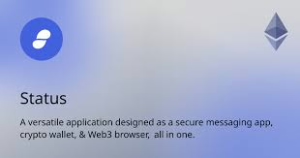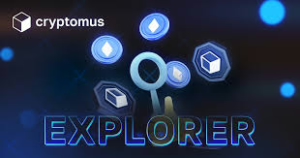Once upon a time in the vast digital realm, there existed a powerful tool known as the Blockchain Explorer. This remarkable online instrument was crafted with the purpose of unveiling the intricate web of information that lay hidden within the blocks, addresses, and the flow of transactions that traverse the blockchain landscape. With a few clicks, users could access a treasure trove of data, including vital metrics such as the network’s hash rate and indexes that illustrated the growth of transactions over time.

However, despite its significance, many individuals—some even well-versed in the world of cryptocurrencies—often overlooked the true worth of the Blockchain Explorer. Yet, for those who took the time to explore its capabilities, a wealth of insights awaited discovery.
At the heart of every block in the blockchain lies a crucial transaction: the rewards earned by miners for their hard work and dedication. Each transaction tells a story, revealing where Bitcoin has journeyed to or from and whether any fees were incurred along the way. Such revelations can be invaluable for anyone looking to understand the expenses they’ve faced in their digital endeavors.
But that’s not all; these explorers go beyond mere transactions. They also keep an eye on unconfirmed transactions, offering a glimpse into the dynamics of mining difficulty—whether it’s on the rise or in decline. These indicators serve as a beacon for users, illuminating potential network congestion and hinting at the likelihood of increasing fees.
In this ever-evolving landscape, those who harness the power of a Blockchain Explorer can navigate with greater wisdom, predicting trends and making informed decisions as they traverse the intricate pathways of cryptocurrency. And so, as more adventurers ventured into this digital domain, they found themselves equipped with knowledge that transformed their understanding of this remarkable technology.
The phrase “Blockchain Explorer” might lead one to believe that these tools are solely designed for examining block data, yet their utility extends far beyond that initial impression. In reality, blockchain explorers serve as powerful instruments for delving into the intricate world of transactions. They allow users to search for specific transaction IDs or wallet addresses, showcasing their effectiveness in scrutinizing individual transactions whenever the need arises.
Moreover, there are other types of blockchain explorers equipped with advanced functionalities for analyzing network statistics and offering visualization charts that can aid in optimizing various processes. However, it’s essential to note that when it comes to tracking cryptocurrency transactions, one must select the appropriate blockchain explorer. For instance, you cannot utilize a Litecoin explorer to monitor Bitcoin transactions; instead, you would need a dedicated Bitcoin explorer to accomplish this task.
So, why should one consider using a blockchain explorer? At first glance, these general explorers may present a bewildering array of data, particularly for those who are just stepping into the realm of cryptocurrency. The information displayed can seem overwhelming and confusing, leaving newcomers unsure of where to begin. However, as users gradually familiarize themselves with the nuances of reading and interpreting these data sets, clarity begins to emerge. Before long, the blockchain explorer evolves into a trusted companion, guiding them through the complexities of Blockchains and Cryptocurrency.
Take, for example, the moment when miners successfully unearth a new bitcoin block. Each blockchain explorer is poised to announce this achievement instantaneously as it becomes part of the network. By clicking on a particular block, users can uncover valuable insights such as its size, discovery details, and most crucially, the transactions contained within it.

A Bitcoin Blockchain explorer can prove to be an invaluable asset when users wish to investigate how current block rewards are allocated to the miners who contributed to solving the block’s hash code. While this information may not be essential for everyone, it provides a fascinating glimpse into how bitcoins are generated through mining and the subsequent distribution process.
Depending on the specific bitcoin blockchain explorer utilized, users may encounter additional features that enhance their experience and deepen their understanding of the ever-evolving cryptocurrency landscape. As individuals navigate this digital terrain, they discover that these explorers are not merely tools but rather gateways to knowledge and insight in an intricate financial ecosystem.
In the realm of cryptocurrency, an adept blockchain explorer serves as a gateway to a treasure trove of insights and data. Imagine stepping into a digital universe where you can:

– Delve into the latest blocks that have been mined on the blockchain, unveiling the most recent additions to this intricate ledger.
– Investigate any transaction nestled within any previously mined block, allowing you to trace the flow of bitcoins with precision.
– Unravel the history associated with any public bitcoin address, revealing its past interactions and transactions.
– Identify both the bitcoin receiving address and the change address, providing a clearer picture of how funds are managed.
– Monitor the Mempool’s status, where one can observe the total count of unconfirmed transactions occurring within a day, painting a snapshot of network activity.
– Track the occurrence of ‘double-spend’ transactions that transpired in the last ten minutes, highlighting the challenges and intricacies of transaction validation.
– Discover which blocks have been rendered ‘orphaned,’ standing detached from the blockchain due to various reasons.
– Ascertain which mining pool was responsible for discovering each block, shedding light on the collaborative efforts behind mining activities.
– Access the genesis block—the very first block to grace the blockchain, marking the inception of this revolutionary technology.
Now, let’s embark on a journey to explore a practical application of these blockchain explorers.
Understanding the Functionality of a Blockchain Explorer
With a firm grasp on what a blockchain explorer is, its uses, and why it is indispensable, we can now turn our attention to how these tools operate.
Picture this: you land on the homepage of Blockchain.com, one of the leading blockchain explorers available today. The first thing that captures your attention is that a blockchain explorer is essentially a Graphical User Interface (GUI) designed to facilitate navigation through the complex world of blockchains. The interface provides an overview of critical data pertaining to the Bitcoin blockchain. Here, you’ll find some remarkable statistics displayed prominently, such as the daily transaction count, total transaction volume, estimated hash rate, and current bitcoin price.
As you scroll down, you encounter charts that meticulously map out price trends alongside the size of the Mempool. The lower section of this explorer’s interface is dedicated to real-time monitoring of blocks and transactions, serving as a pulse-check on blockchain activity.
Let’s further dissect the various components that make up this powerful tool:

Price:
This segment showcases an aggregated feed of USD prices sourced from various markets. You have the option to select your preferred currency through a convenient drop-down menu. Often, the price displayed here is tied directly to the provider of this information rather than reflecting real-time spot prices.

Transactions:
On the Blockchain.com homepage, there exists a fascinating section dedicated to showcasing the myriad of unique transactions that have taken place over the last 24 hours. Each of these transactions holds a significant place within a validated block, marking its confirmation and ensuring its integrity within the expansive network.
Estimated Hash Rate:
When it comes to understanding the security dynamics of a Proof of Work (PoW) Blockchain, the estimated hash rate serves as an invaluable metric. This figure is often regarded as a benchmark for assessing the overall safety of the blockchain environment. Additionally, blockchain explorers provide a captivating visual representation that illustrates the anticipated computational power utilized by miners, shedding light on their tireless efforts to maintain network security.
Mempool Size:
Delving deeper into the workings of the blockchain, one can encounter the mempool size—a crucial element that allows users to monitor the cumulative size of transactions waiting to be added to a specific block. Typically measured in bytes, this component not only provides insight into pending transactions but also highlights the fees associated with expediting their confirmation, offering a glimpse into the bustling activity of the blockchain ecosystem.
Transaction Volume:
As we explore further, we arrive at transaction volume, which encapsulates the total value of outputs successfully confirmed on the blockchain within the recent 24-hour timeframe. This metric serves as a testament to the vibrant and dynamic nature of transactions occurring within this decentralized network.

Estimated Transaction Volume:
Next, we come across an intriguing estimate known as the estimated transaction volume. This figure represents the actual volume of transactions exchanged among distinct wallets. It is derived from calculating the difference between the total transaction value and the expected output that returns as change to the spending wallet, painting a clearer picture of the flow of assets within the network.
Latest Blocks:
Finally, we reach one of the most essential features within the blockchain explorer—the latest blocks. This section stands out for its functionality, meticulously detailing each confirmed block in chronological order from newest to oldest. Here, users can find vital information about blocks, including timestamps, block sizes, and block heights, offering a comprehensive overview of recent developments within the blockchain landscape.

In this intricate web of transactions and data, each element plays a pivotal role in weaving together the tapestry of blockchain technology, illustrating its complexity and brilliance in equal measure.
The Genesis of Blockchain Explorers
The idea of a Blockchain Explorer emerged in tandem with the advent of Blockchain technology itself. This innovation was crafted as a remedy for the challenges faced when trying to navigate the vast and intricate world of Blockchain transactions. Imagine needing to confirm whether someone’s assertion of sending cryptocurrencies was indeed accurate; this is where the necessity for such an explorer became evident. Occasionally, those transactions might have encountered hiccups along the way, either being stalled or outright rejected.

Compounding these issues is the inherent complexity of traversing Blockchains, primarily due to variations in how data is formatted across different platforms. Blockchains meticulously organize their data in a structured manner, utilizing proper indexing and grouping. As a result, there has always been a pressing demand for specialized software that can enhance the accessibility and readability of the information contained within these digital ledgers.
In the early days, the primary method available for delving into Blockchain transactions was through a Command-line interface. However, this approach necessitated a level of programming skill that was beyond the reach of most users. Thus, there arose a clear need for a more user-friendly graphical interface to facilitate easier navigation of Blockchain platforms and make them more approachable for everyday users.
The first Blockchain Explorer was specifically designed for the Bitcoin Blockchain and made its debut in 2010, coinciding with the launch of Bitcoin itself. This pioneering explorer provided essential data related to Bitcoin transactions and was later transitioned to blockexplorer.com, which offered real-time statistics pertaining to the Bitcoin Blockchain.

Delving Deeper into the Explorer
Now, let us embark on a more thorough exploration of what a Blockchain Explorer entails, seeking to unravel its various components and functionalities. To illustrate these elements clearly, we will turn our attention to the CoinMarketCap Blockchain Explorer. With this tool at our disposal, we can examine the different facets that comprise a Blockchain Explorer.
The Homepage
Here, on the homepage, users are greeted with a streamlined layout designed for ease of use. It serves as the gateway to an array of functionalities that allow for seamless exploration of Blockchain data. Each section is intuitively organized, ensuring that even those new to cryptocurrency can navigate with confidence. Whether you’re tracking transactions or examining network statistics, the homepage acts as your command center for all things related to Blockchain exploration.
As we journey through this interface, we’ll uncover how each component interacts and contributes to our overall understanding of Blockchain technology—a world that continues to evolve and expand with each passing day.

Welcome to the Main Page
As you navigate through the website, your journey begins at the main page, adorned with various essential features. On the left side of the header, you’ll notice the CoinMarketCap logo, a handy gateway that allows you to return to this starting point whenever you wish—just a click away.
Discovering CoinMarketCap
To enhance your experience, there’s an option to select your preferred language via the drop-down menu situated on the right. Adjacent to this is a compact search bar designed for those eager to delve into the intricacies of Bitcoin’s blockchain. With a simple click, you can effortlessly switch your focus to other blockchains such as Ethereum or Litecoin.

Exploring Ethereum
Primary Search Feature
The primary search feature serves as your immediate tool for finding specific information. As an explorer of blockchains, you can utilize this function to search for various elements, including:
– Blocks: Discover block height or number.
– Transactions: Input a transaction hash or ID.
– Wallets: Enter a wallet address.
– Ethereum Name Service (ENS)
By default, the search bar is set to explore the Bitcoin blockchain; however, you can easily adjust it to focus on Ethereum or Litecoin by clicking the dropdown arrow. One of the most prevalent uses for blockchain explorers is tracking transaction statuses. This can be accomplished by copying and pasting the transaction ID into the search bar. Additionally, it allows users to verify whether the anticipated cryptocurrency has successfully arrived in their wallets. The block explorer will showcase the wallet address along with all recent transactions associated with it.

Insights into Blockchain Activity
As you scroll further down the main page, an overview of Bitcoin, Ethereum, and Litecoin blocks comes into view. Here, you can find the latest prices for one Bitcoin, Ethereum, and Litecoin, all displayed in US Dollars with real-time updates. The data is dynamic, continuously changing as cryptocurrencies are bought, sold, and mined.
Market Insights
Beneath each cryptocurrency, key market data points are presented. These figures reveal vital details about the value and market capitalization of each coin, providing investors and analysts with crucial insights into the current state of the cryptocurrency landscape. This wealth of information is invaluable for anyone looking to understand the ever-evolving market trends and make informed decisions based on them.
The Chronicles of Recent Blocks
In the ever-evolving landscape of blockchain technology, a captivating spectacle unfolds with the display of Recent Blocks. These vibrant groupings, illustrated by dynamic blue and yellow graphs, symbolize the confirmed transactions etched into the annals of the Bitcoin and Ethereum Blockchains. This visual representation is not static; it breathes with life, as it updates continuously. The height of each bar serves as a beacon, illuminating the volume of transactions—taller bars indicate a flurry of activity, while shorter ones suggest a quieter moment in the bustling world of cryptocurrencies.
Exploring the Depths of Blocks
For those curious souls seeking deeper insights into a particular block, a simple yet effective method awaits. Hovering over the three little dots and selecting “View Blocks” opens a portal into the intricate workings of blockchain. A click on any block height reveals a treasure trove of transactions nestled within that specific block, providing a closer look at the digital exchanges taking place.

Yet, if one inadvertently strays from the homepage, fear not! A handy search bar graces the top right corner of the page, guiding users back to their desired block transactions with ease.
Delving into Transactions
As one embarks on a journey through Bitcoin’s vast data landscape, they can navigate to the “Transactions” tab, where individual transactions lie in wait within their respective blocks. Here, these transactions represent the fundamental act of sending and receiving cryptocurrency—an exchange that fuels the blockchain ecosystem. Each transaction is tagged with a unique identifier known by many names—TxHash, TxID, Hash ID—and is crafted by a sophisticated hashing algorithm that encodes vital details of that transaction.
These Hash IDs serve as digital fingerprints, irrefutable proof of payment. Any alteration to the transaction’s details will invariably alter the Hash ID, thus raising an alarm for users that something amiss has occurred. Recipients of cryptocurrency can verify the status of their transactions by consulting the Hash ID, confirming whether their digital assets have successfully arrived.

The Saga of Block Rewards
At the heart of this intricate system lies the concept of Block Rewards, bestowed upon miners—the unsung heroes of the blockchain realm. These individuals engage in an intense global competition, racing against one another to crack cryptographic puzzles and produce Proof-of-Work. In doing so, they meticulously verify transactions to ensure that each Bitcoin remains accounted for and hasn’t been spent elsewhere in this decentralized universe. The miner who first solves the puzzle is crowned with the coveted Block Reward, while their fellow miners diligently validate this solution, collectively reaching a consensus on the integrity of the data presented.
Thus unfolds the ongoing saga of blockchain technology—a world where every block tells a story, every transaction holds significance, and miners tirelessly work to uphold the sanctity of this revolutionary digital ledger.
There is little question that Blockchain technology is on an upward trajectory, poised to extend its reach beyond the realm of cryptocurrencies and into a variety of other sectors. In this blog post, we embark on a journey through the fascinating world of Blockchain Explorers. We begin by unraveling the essential components that make up an explorer, delving into the mechanics of how it operates, and tracing its intriguing origin story. As we traverse this landscape, we aim to provide a thorough exploration of Blockchain Explorers, offering readers a rich and detailed perspective on this compelling subject.
Maxthon: A Private Browsing Experience for the Digital Age
In a time when the internet is woven deeply into the fabric of our daily lives, protecting our digital identities has become more crucial than ever. Imagine setting off on an exhilarating journey through the vast and often uncharted realms of cyberspace, where each click reveals hidden gems of knowledge and thrilling adventures. However, amidst this expansive virtual world, lurking threats jeopardize our personal information and overall security. To navigate this intricate online landscape with assurance, it is essential to select a browser that places user safety at the forefront. This is where Maxthon Browser steps in—a reliable ally on your digital expedition, and the best part? It comes at no cost.

Maxthon Browser: Designed with Windows 11 Users in Mind
What distinguishes Maxthon from traditional web browsers is its steadfast focus on maintaining online privacy. Envision it as a watchful protector, always on guard against the myriad dangers that lie within the digital wilderness. With a remarkable array of built-in features—including ad-blockers and anti-tracking tools—Maxthon actively safeguards your online presence. As users traverse the internet on their Windows 11 devices, these protective elements create a robust barrier against intrusive ads and stop websites from surveilling browsing habits.
As one journeys through the dynamic digital landscape on a Windows 11 device, the importance of Maxthon’s commitment to privacy becomes increasingly clear. Utilizing state-of-the-art encryption techniques, it ensures that sensitive information remains protected throughout your online adventures. Thus, as users delve into the unknown territories of cyberspace, they can embark on their digital quests with peace of mind, confident that their data is secure from prying eyes.
